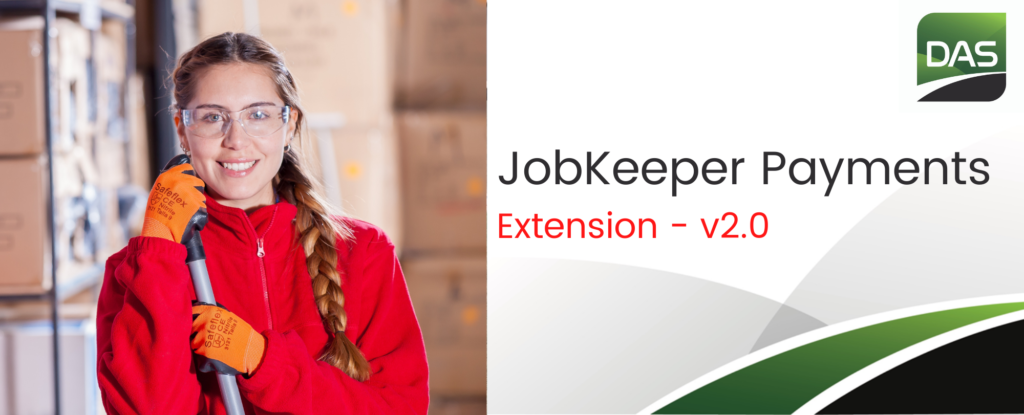
(updated 21st Sep 2020)
JobKeeper 1.0 ends on 27 September 2020. Those needing further support will need to reassess their eligibility and prove an actual decline in turnover to be eligible to enter JobKeeper Extension 2.0.
To receive JobKeeper from 28 September 2020, eligible employers need to assess their decline in turnover with reference to their actual GST turnover for the;
- September 2020 quarter (for payments between 28 Sep to 3 Jan 2021), and again for the
- December 2020 quarter (for payments between 4 Jan 2021 to 28 Mar 2021)
From 28 September 2020, the JobKeeper payment rate will reduce and split into a higher and lower rate based on the number of hours the employee worked in a specific 28 day period prior to 1 March 2020 or 1 July 2020.
From 28 September 2020, the eligibility tests to access JobKeeper for employers will change, as will the amount of the JobKeeper payment for employees and business participants. To receive JobKeeper from 4 January 2021, employers will need to assess their eligibility again.
Is it worth noting that eligibility for one JobKeeper period does not entitle you to, or exclude you from, payments in another period. Each eligibility period is addressed separately. That is, there might be businesses that qualified for the first tranche of JobKeeper, don’t qualify for the second tranche but qualify for the third.
The decline in turnover test
|
30 Mar to 27 Sep 2020 (JobKeeper 1.0) |
28 Sep to 3 Jan 2021 (JobKeeper Extension) |
4 Jan 2021 to 28 Mar 2021 (JobKeeper Extension) |
|
| Decline in turnover test | Projected GST turnover for a relevant month or quarter is expected to fall by at least 30% (15% for ACNC-registered charities, 50% for large businesses) compared to the same period in 2019.* | Actual GST turnover in the Sep 2020 quarter (Jul, Aug & Sep) fell by at least 30% (15% for ACNC-registered charities, 50% for large businesses) compared to the same period in 2019.* | Actual GST turnover in the Dec 2020 quarter (Oct, Nov & Dec) fell by at least 30% (15% for ACNC-registered charities, 50% for large businesses) compared to the same period in 2019.* |
How do I calculate my GST Turnover?
- Calculating GST turnover for extension part 2 & 3 is different to the original JobKeeper requirements
- Entities will only be using current GST turnover figures (not projected GST turnover)
- When applying the new turnover reduction tests for the Sep 2020 quarter and Dec 2020 quarter, entities that are registered for GST must use the same method that is used for GST reporting purposes. That is, if the entity is registered for GST on a cash basis then a cash basis must be used to calculate current GST turnover for the purpose of these new tests.
- Entities that are not registered for GST must use the method they ordinarily calculate their income for tax purposes.
- Current GST turnover includes proceeds from the sale of capital assets, unless the sale is input taxed.
- Current GST turnover includes taxable and GST-free supplies, but should exclude input taxed supplies such as residential rental income and financial supplies like dividends, interest etc.
- JobKeeper and ATO cash flow boost payments should be excluded from the calculation along with other payments that don’t represent consideration for a supply made by the entity such as certain State based grants.
What are the Jobkeeper Payments?
From 28 September 2020, the payment rate for JobKeeper will taper from the flat rate of $1,500 and split into a higher and lower rate.
| JobKeeper payment |
30 Mar to 27 Sept 2020 (JobKeeper 1.0) |
28 Sep to 3 Jan 2021 (JobKeeper Extension) |
4 Jan 2021 to 28 Mar 2021 (JobKeeper Extension) |
| Worked 80 hours or more in the reference period | · $1,500 per fortnight per employee | · $1,200 per fortnight per employee or business participant | · $1,000 per fortnight per employee or business participant |
| Worked less than 80 hours in the reference period | · $750 per fortnight per employee or business participant | · $650 per fortnight per employee or business participant |
What is the reference period I use?
|
Reference period |
Hours |
|
| Eligible employees | The 28 days finishing on the last day of the last pay period that ended before either:
· 1 March 2020, or · 1 July 2020. |
Actual hours worked including any hours for which they received paid leave (e.g., annual, long service, sick, carers and other forms of paid leave) or paid absence for public holidays. An employee’s ‘actual’ hours might be different to their contracted, ordinary hours or hours they are paid for. |
| Eligible business participants | February 2020 (29 days) | Active engagement in the business. |
| Religious practitioners | February 2020 (29 days) | Activities in pursuit of your vocation for your institution. |
Business Participants and Sole Traders
The reference period that a business participant must use is the month of February 2020 (the whole 29 days).
A business participant is;
- a sole trader or self-employed with an ABN
- one partner in a partnership
- adult beneficiary of a trust
- director or shareholder who works in the business
only one person in a partnership, one beneficiary of a trust, or one director / shareholder can be eligible for JobKeeper payments for a particular entity).
The test to determine eligibility is based on the hours of active engagement in the business carried on by the entity. This requires an assessment of the hours that the business participant was actively operating the business or undertaking specific tasks in business development and planning, regulatory compliance or similar activities in an applicable reference period.
Other than sole traders, a business participant must provide a declaration to the business entity confirming their hours worked over the reference period.
For JobKeeper payments from 28 September 2020, the business must notify the Tax Commissioner about whether the higher or lower rate applies to the business participant and notify the participant within 7 days of providing this notice to the Commissioner.
Where February 2020 was not typical of the participant’s hours, an alternative test can be used
Need our Help?
If you would like our assistance assessing the criteria, eligibility or applying for the JobKeeper Extension, please contact our office to receive an engagement and fees proposal.

